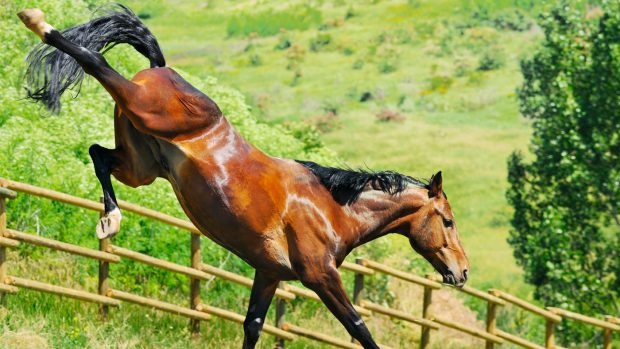It is easy to forget that mares are ‘entire’ animals and, as such, may be prone to hormonal imbalances. This can result in what is commonly known as ‘marish’ behaviour, which can sometimes make life difficult for owners and riders, particularly within the competitive sphere.
Around 10 per cent of mature mares suffer symptoms affecting their performance around the time of oestrus. Despite this, the syndrome is not well understood and there is little comparative research to enable owners and vets to choose the best treatment.
The symptoms
- Oestrus-related problems range from symptoms of pain, aggression and reduced willingness to work to signs of sexual receptiveness that are out of place in the competition ring.
- Affected mares may suffer from colic, or resent grooming or tacking up – they may also urinate repeatedly.
- Symptoms may be most marked during the first season of the year, or occur at every oestrus, but are normally absent in the winter, when most mares won’t come into season.
It is impossible to know for sure what mares feel as they ovulate, and much evidence relating to ‘marish’ behaviour is anecdotal. However, a proportion of women experience pain linked to ovulation and some mares suffer otherwise unexplained colic at this time, suggesting that ovulation may be painful for them, too.
Another potential source of pain during oestrus is traction on the ovarian ligament, caused by a 4-5cm diameter follicle (egg) hanging into the abdomen. This is usually seen in older mares, as they have heavier ovaries and longer ovarian ligaments.
The hormones associated with oestrus may also cause some of the symptoms. Increased oestrogen acts on the behavioural centres of the brain to induce sexually responsive behaviour, and may be linked to greater sensitivity or aggression. This may reflect the fact that the mare’s biological drive during oestrus is to mate, overriding her training and her willingness to perform.
Supplementation as treatment
The most common treatments for marish behaviour are herbal or food supplements. Most contain a mixture of herbs, including some that have a mildly sedative effect and others thought to act on the hormonal system. For example, the chaste tree berry (a common ingredient) is thought to act on the pituitary gland to suppress seasonal activity.
The problem with herbal supplements is that it is difficult to know which mares will respond to which product – it can be worth trying several over time to see which works best for your horse.
Bear in mind that some products contain substances banned under FEI or Jockey Club rules, so they should not be used in competing mares unless the manufacturer can guarantee that they comply with regulations.
The most effective treatment is to prevent seasons, thus avoiding both the hormonal and physical effects. There are a number of possible methods, with more being developed. Most either suppress oestrus behaviour altogether or mimic pregnancy, which in turn suppresses symptoms.
The ‘equine pill’ option
Regumate Equine is an oral, hormonal treatment that mimics progesterone (which is released during pregnancy) and acts to prevent oestrus.
A recent ruling stated that it may be used in horses competing under FEI regulations, and as a result its popularity is set to continue. However, withdrawal of this medication results in the resumption of normal cycles, so prolonged daily treatment is needed for ongoing oestrus prevention.
A recent development in the USA – likely to appear soon in the UK – is a long-acting injectable progestagen (a substance that mimics progesterone), which achieves the same results as Regumate, but requires just one injection every two weeks, reducing costs as a result.
Ongoing research has resulted in the development of an anti-GNRH (a hormone linked to reproduction) vaccine that aims to prevent oestrus. Although still at the experimental stage, this treatment may offer hope to affected mares in the future.
Some owners find that using a low dose of phenylbutazone (bute) around the time of oestrus can reduce pain and inflammation, although this cannot be used in mares competing under FEI or Jockey Club rules.
Long-term management
As the symptoms of ovarian pain tend to become more marked with age, and are generally not associated with any underlying problem or disease process that needs to be cured, affected mares often need ongoing treatment to allow them to continue to work.
Finding the appropriate medical and management methods that regulate the symptoms for your particular mare is the key to long-term management. Rest around the time of oestrus is also an option – after all, wouldn’t you rather stay in bed?
The normal oestrus cycle
to increase the longevity of the corpus luteum, maintaining pregnancy and preventing oestrus.
Controversial techniques
Roberta says: “An alternative method for controlling marish behaviour is now available that involves creating an unwanted pregnancy in the affected mare (usually by artificial insemination), then preventing development of the embryo from about 16-17 days of pregnancy by ‘nipping’ it during a rectal examination.
“This method suppresses seasons for three to four months and can be repeated to prolong the effect. It works because in the second week after conception, the developing embryo induces the mare to produce hormones that maintain the false pregnancy for the first trimester, even if the embryo does not survive beyond this time.
“In the USA a few years ago, an attempt was made to mimic a three- to four-month false pregnancy by inserting a marble into a mare’s uterus. The theory was that it could induce hormones that maintain pregnancy, like an early embryo. However, it carries the risk of infection and of creating adhesions in the uterus. Also, the marble may be difficult to recover, so the treatment is not recommended.”
Steps to take if you think your horse suffers from ‘marishness’
|





